Social media has become an integral part of our daily lives, and businesses are leveraging its power to connect with their target audience and promote their brand. But creating compelling and effective content for social media can be a daunting task.
In this guide, we’ll delve into the content creation process, discuss the specifics of social media content creation strategy, and provide you with 10 easy steps to master your social media content creation in 2024.
Plus, we’ll explore the role of social media content creation tools and highlight five companies that excel at their social media efforts.
What is the content creation process?
The content creation process is a systematic approach of developing and producing engaging and valuable content for various platforms. It involves several key stages, beginning with planning and research to identify target audience, goals, and content types.
The next step is ideation, where ideas are brainstormed and concepts are formed. Once ideas are finalized, content creation begins, which may involve writing, designing, or producing multimedia assets.
Afterward, content goes through an editing and reviewing phase to ensure quality and accuracy. Lastly, distribution and promotion strategies are implemented to reach the intended audience effectively.
The content creation process is iterative, requiring continuous analysis and refinement to optimize results and deliver impactful content.
Supercharge your social media creation process
Get point-and-click feedback on your social media posts with Filestage.
What makes social media content creation strategy unique?
Social media content creation strategy has its own distinct characteristics that set it apart from other marketing channels.
Here’s what makes social media unique compared to other marketing channels:
- It’s interactive
- It thrives on visual content
- There’s often has character limit
- It requires an understanding of platform algorithms
- It’s constantly evolving
Let’s look at each of those areas in a bit more detail.
Interactivity
Social media platforms are inherently interactive, allowing for immediate and direct engagement with the audience. This means that your social media strategy should be bulletproof when it comes to timely responses, active participation, and fostering conversations.
The need for visual content
Social media thrives on visual content. Platforms like Instagram, TikTok, and Pinterest heavily rely on captivating visuals to grab attention and drive engagement.
As a result, social media content creators must prioritize visually appealing and attention-grabbing imagery or videos. This helps you make sure your content stands out among the constant stream of updates.
Character limits
Social media platforms often have character or length limitations, such as Twitter’s 280-character limit or Instagram’s caption restrictions.
This demands concise and impactful messaging that will accurately communicate the message within those given parameters. Content creators must carefully craft their messages to be concise, engaging, and memorable.
Understanding of platform algorithms
Social media content creation strategy requires an understanding of platform algorithms and best practices. Each platform has its own unique set of rules, including content formats, posting frequency, and optimization techniques.
Adapting content to fit these specific requirements is crucial for maximizing visibility and engagement.
Constantly evolving
At the end of the day, social media content creators must be agile and adaptable to make sure they always stay on top of the latest trends. The digital landscape is constantly evolving, and trends change rapidly.
Keeping up with the latest features, trends, and emerging platforms is essential to stay relevant and maintain a competitive edge.
10 easy steps to master your social media content creation strategy
Here are 10 easy-to-follow steps to help you master your social media content creation strategy:
- Define your goals
- Know your target audience
- Select the right platforms
- Create a content calendar
- Mix up your content
- Optimize content for each platform
- Use relevant hashtags
- Engage with your audience
- Analyze and refine
- Stay up to date and experiment
1. Define your goals
Defining your goals is a critical first step in mastering your social media content strategy. It involves identifying what you want to achieve through your social media efforts.
Here are some of the goals you can set when defining your social media content strategy:
- Increasing brand awareness
- Driving website traffic
- Generating leads
- Boosting sales
- Improving customer engagement
- Establishing thought leadership
By clearly defining your goals, you can align your content strategy and tactics to support these objectives. This way, you’ll be able to measure the success of your social media efforts, track key performance indicators (KPIs), and make data-driven decisions to optimize your content and achieve the best possible outcomes.
Setting specific, measurable, attainable, relevant, and time-bound (SMART) goals allows you to focus and provides a roadmap for success in your social media content journey.
2. Know your target audience
Knowing your audience is crucial for creating content that resonates with them. This step involves conducting comprehensive research to understand the demographics, interests, preferences, and behaviors of your target audience.
By gathering insights about their age, gender, location, challenges, and aspirations, you can tailor your content to meet their specific needs. Understanding their preferred social media platforms and communication styles allows you to effectively engage with them.
This knowledge helps you craft compelling messaging, select relevant topics, and choose the right content formats that appeal to your audience.
By knowing your audience intimately, you can create content that establishes a genuine connection, fosters loyalty, and drives meaningful engagement with your brand.
3. Select the right platforms
Selecting the right platforms is essential for maximizing the impact of your social media content strategy. It requires understanding where your target audience is most active and engaged.
Here are the three most important things to consider when starting your research:
- Age
- Demographics
- Interests
Once you find out where your audience likes to hang out, focus your efforts on these platforms to effectively reach and connect with them.
Another important thing to know is that each platform has its own unique features, demographics, and content formats. Consider your brand’s messaging and content type to determine which platforms align best with your objectives.
By strategically choosing the right platforms, you can concentrate your resources, tailor your content to platform-specific best practices, and build a strong online presence where your target audience is most receptive.
4. Create a content calendar
Creating a content calendar is a vital step in mastering your social media content strategy. It involves planning and organizing your content in advance to make sure you’re being consistent and following your predefined strategy.
A content calendar provides a bird’s-eye view of your content strategy, allowing you to map out topics, themes, and key messages for each platform. It helps you maintain a consistent posting schedule, avoid gaps or content overload, and ensure a diverse mix of content types.
By planning ahead, you can optimize your content creation process, collaborate effectively with team members or stakeholders, and allocate resources efficiently. A well-structured content calendar also allows for better analysis and evaluation of your content’s performance, enabling you to make data-driven decisions and refine your strategy as needed.
With a well thought out content calendar, you’ll be able to streamline your social media content creation efforts to create cohesive and engaging content that resonates with your audience.

5. Mix up your content
Creating a mix of content types is essential for maintaining audience interest and engagement. By diversifying your content, you can cater to different preferences and capture your audience’s attention in various ways.
Experiment with a combination of text, images, videos, infographics, polls, and user-generated content.
Here’s how different types of content boost your social media efforts:
- Text-based content – provides valuable information or storytelling
- Visuals and videos – highly engaging and shareable
- Infographics and polls – convey information in a visually appealing and interactive format
- User-generated content – fosters a sense of community and shows real-life experiences with your brand
By mixing up your content, you can keep your social media feed dynamic, capture different audience segments, and cater to diverse learning and engagement styles. It’s important to analyze the performance of different content types to understand what resonates most with your audience and refine your content mix accordingly.
6. Optimize content for each platform
Optimizing your content for each social media platform is crucial for maximizing its impact and engagement. So instead of copy and pasting your posts from one platform to another, examine each platform’s content specifications, best practices, and user behavior patterns.
Here are some things you can do to optimize your content for each social media platform:
- Adapt your image sizes
- Make shorter video clips out of a longer video
- Create copy that satisfies character limits
Adapt your content to fit the visual style and tone of each platform to make sure it resonates with the audience.
By using features unique to each platform like Instagram Stories, Twitter hashtags, or LinkedIn posts, you’ll enhance engagement and have optimized content for each platform. And to maximize success, you can tailor your messaging to align with the platform’s audience demographics and communication style.
Optimizing your content for each platform will help you increase its visibility, improve user experience, and drive higher engagement and conversions. Regularly monitor platform updates and user feedback to stay informed and adapt your optimization strategies accordingly.
7. Use relevant hashtags
Using relevant hashtags is an effective way to expand the reach and discoverability of your social media content. Hashtags categorize content and make it easier for users to find information on specific topics.
Research and identify popular and niche hashtags that align with your content and industry. Then, incorporate these hashtags strategically in your posts to increase visibility and attract a broader audience.
But have in mind that it’s important to use relevant hashtags that are specific to your content, as generic or unrelated hashtags may not yield the results you desire. At the end of the day, monitor the performance of your hashtag usage and adapt your strategy accordingly.
By using relevant hashtags, you can boost your content’s reach, increase engagement, and connect with users who have an interest in the topics you cover.
8. Engage with your audience
Engaging with your audience is a vital step in social media content creation. It involves actively interacting with your followers, responding to comments, messages, and mentions promptly. Engaging with your audience fosters a sense of community and builds trust in your brand.
By engaging with your audience, you’ll create a two-way communication channel that strengthens relationships, increases brand loyalty, and encourages user-generated content. That’s why it’s a good practice to encourage conversations by asking questions, seeking opinions, and responding to messages thoughtfully.
Show genuine interest in your audience’s feedback and address their concerns or inquiries promptly.
Plus, engaging with your audience provides valuable insights into their preferences, needs, and interests, allowing you to refine your content strategy and deliver more relevant and impactful content. Audience engagement helps you foster a loyal and enthusiastic community that actively participates in your brand’s social media presence.
9. Analyze and refine
Analyzing and refining your social media content is crucial for optimizing your strategy and achieving better results.
Here are a few stats you should regularly track and evaluate as a part of your social media content strategy:
- Engagement
- Reach
- Clicks
- Conversions
- Follower growth
By using social media analytics tools and insights provided by each platform you can gain valuable data and identify trends, patterns, and successful content types that resonate with your audience.
Based on these insights, you can refine your content strategy by focusing on high-performing content, adjusting posting frequency, experimenting with different formats, or targeting specific audience segments.
Continuously monitor and track the impact of your refinements to make sure they are delivering the results you’re looking for. This iterative process allows you to adapt, learn, and evolve your social media content creation strategy to achieve optimal engagement and business results.
10. Stay up to date and experiment
Staying up to date and embracing experimentation are essential for staying ahead in the ever-evolving landscape of social media. Always make sure you know about the latest trends, algorithm changes, and new features introduced by social media platforms.
This knowledge will allow you to adapt your content strategy and leverage emerging opportunities. On the other hand, you should also embrace experimentation by trying out new content formats, testing different approaches, and exploring innovative ideas.
By experimenting, you can uncover what resonates best with your audience and discover new ways to engage them. Don’t be afraid to make mistakes but continuously evaluate the results of your experiments, analyze data, and iterate based on insights gained.
Staying updated and experimenting ensures that your social media content remains fresh, relevant, and appealing, helping you maintain a competitive edge and drive meaningful engagement with your audience.
How social media content creation tools can help execute your strategy
Social media content creation tools play a crucial role in effectively executing your social media content strategy.
These tools offer a range of features and functionalities that streamline various aspects of digital content creation – allowing you to save time, improve productivity, and achieve better results.
Here are the five most common types of social media tools:
- Content creation tools
- Scheduling and automation tools
- Collaboration tools
- Analytics and tracking tools
- Social listening tools
Content creation tools
Content creation tools provide templates and design features that simplify the creation of visually appealing graphics, videos, and infographics.
They often come with pre-designed layouts, fonts, and color schemes, allowing even those with limited design skills to produce professional-looking content. This helps you make sure that your visuals align with your brand identity and captivate your audience.
Scheduling and automation tools
Scheduling and automation tools allow you to plan and schedule your social media posts in advance. Whether you’re present of Facebook, Instagram, or LinkedIn (or all of them), you can create a content calendar and set specific dates and times for your posts to be published.
This eliminates the need for manual posting, making sure you have a consistent presence on social media and freeing up time for other important tasks.
Collaboration tools
Collaboration tools facilitate teamwork and streamline the content creation process when working with a team. They allow team members to collaborate, review, and provide feedback on content, and make sure you have a smooth social media workflow and consistent messaging.
Analytics and tracking tools
Analytics and tracking tools provide insights into the performance of your social media content. They offer metrics such as engagement rates, reach, clicks, and conversions, enabling you to measure the effectiveness of your content and make data-driven decisions.
These tools help you understand which types of content are resonating with your audience, allowing you to optimize your strategy accordingly.
Social listening tools
Social listening tools monitor conversations happening on social media, providing valuable insights into trending topics, sentiment analysis, and competitor analysis.
By understanding what people are talking about and how they perceive your brand, you can tailor your content to align with their interests and needs.
Supercharge your social media creation process
Get point-and-click feedback on your social media posts with Filestage.
Top five social media tools you should start using today
Social media content creation is an elaborate effort that requires multiple stakeholders and the usage of various different tools.
Here’s a list of the top five social media content creation tools with different purposes:
- Canva – best content creation social media tool
- Hootsuite – best scheduling and automation social media tool
- Filestage – best review and approval social media tool
- Sprout Social – best analytics and tracking tool
- Brandwatch – best social listening tool
1. Canva – best content creation social media tool
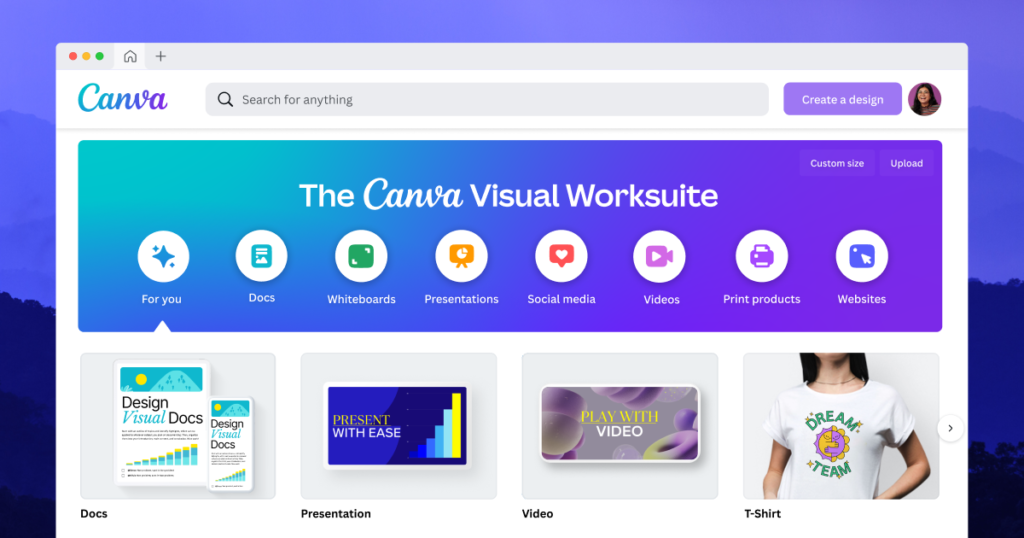
Canva is a popular and user-friendly graphic design tool that empowers users to create professional-looking visuals without the need for extensive design skills. It provides a wide range of customizable templates, graphics, and fonts to assist in creating eye-catching designs for social media posts, presentations, posters, and more. As such, it’s the visual content tool of choice for many creators.
Canva offers both a free version with limited features and a premium subscription with additional functionalities and access to a larger library of assets.
Pros
- User-friendly interface
- Abundance of templates
- Personalized templates that allow you to modify colors, fonts, and other elements
- Wide selection of design assets(including graphics, images, icons, and fonts to enhance designs
- Canva allows multiple users to collaborate on designs
Cons
- Limited customization options
- Template-based design
- Limited control over fine details
- Limited file format support
- Pricing limitations
2. Hootsuite – best scheduling and automation social media tool
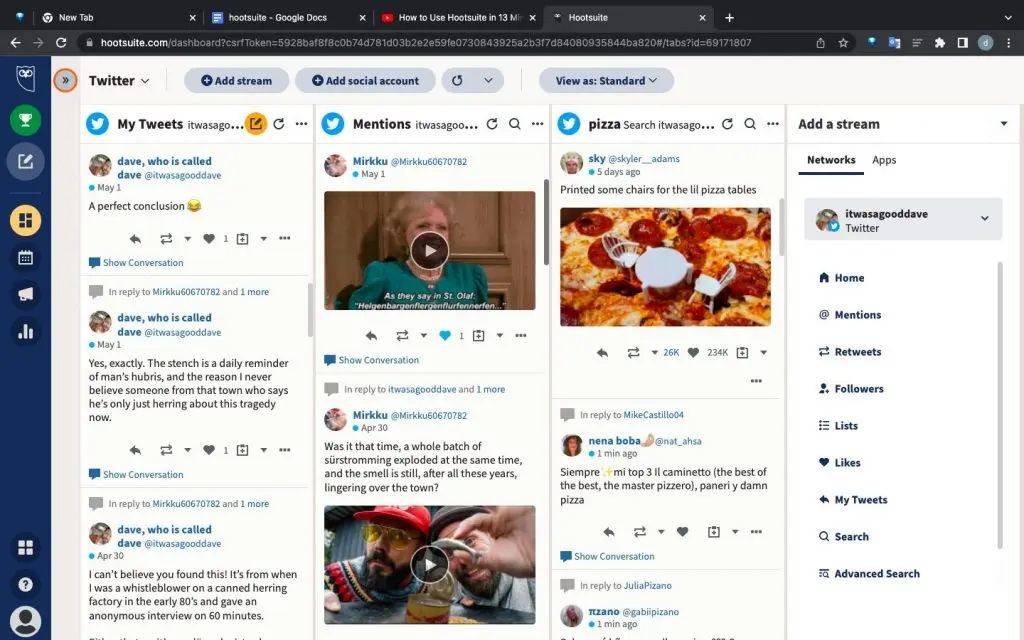
Hootsuite is a popular social media management platform that allows you to efficiently manage and schedule content across multiple social media networks from a single dashboard.
It provides businesses and individuals with tools to monitor brand mentions, engage with followers, and analyze performance metrics. Hootsuite streamlines social media marketing efforts, facilitating consistent posting and strategic audience targeting.
Pros
- Centralized social media accounts management
- Scheduling efficiency
- Analytics and reports
- Team collaboration
- Customizable streams for monitoring mentions, keywords, and trending topics
Cons
- Costly plans
- Limited real-time engagement
- Interface complexity
- Third-party integration
3. Filestage – best collaboration tool for reviewing social content
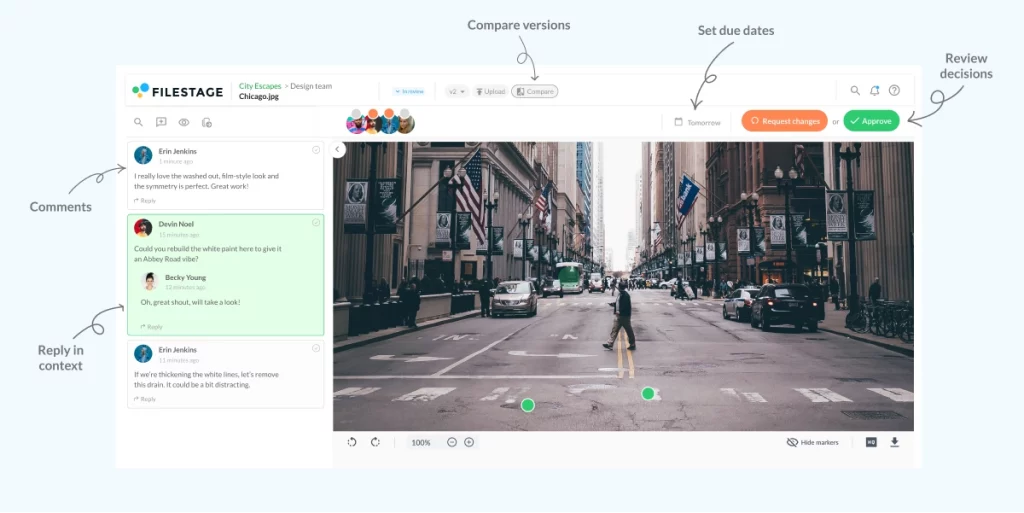
Filestage is an online review and approval platform that streamlines the process of reviewing and collaborating on your social media content. It simplifies the review workflow for teams, enabling seamless communication and feedback exchange on files such as documents, designs, videos, and images.
With Filestage, users can easily upload files, invite stakeholders to review and comment, track changes, and manage approvals in a centralized platform.
Its user-friendly interface and intuitive features make it a valuable tool for creative teams, agencies, and freelancers looking to streamline their review process and improve collaboration efficiency.
Pros
- Filestage simplifies the review process, allowing stakeholders to provide feedback directly on files, eliminating the need for lengthy email threads or in-person meetings
- All feedback and comments are consolidated in one platform, making it easy to track and address revisions
- Filestage enables seamless collaboration and version control, guaranteeing everyone is working on the latest version of a file
- The platform automates repetitive tasks, such as notifications and reminders, saving time and improving workflow efficiency.
- It offers visual annotation tools that allow reviewers to provide precise feedback directly on the file, enhancing clarity and reducing miscommunication
Cons
- No mobile app
4. Sprout Social – best analytics and tracking tool
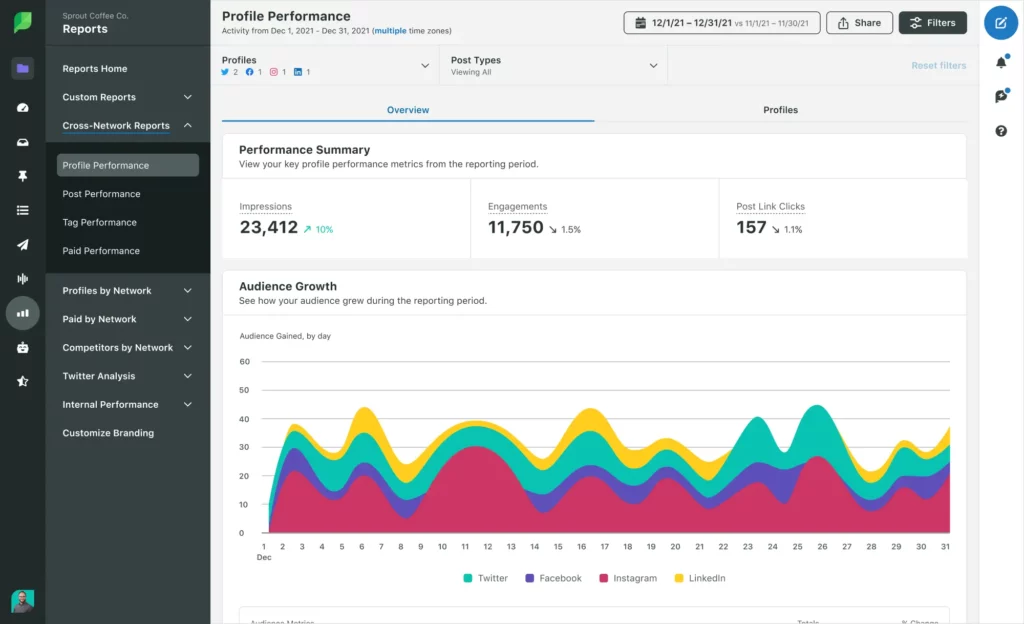
Sprout Social is a comprehensive social media management platform designed to help businesses streamline their online presence. It offers a unified dashboard for managing various social media accounts, scheduling posts, monitoring brand mentions, and analyzing performance data.
With a user-friendly interface and robust features, Sprout Social empowers marketers to optimize their social media strategies and engage effectively with their audience.
Pros
- Easy-to-navigate dashboard, suitable for both beginners and experienced users
- Provides a wide range of tools, reducing the need for multiple platforms
- Offers in-depth analytics and reporting to measure campaign success
- Facilitates team collaboration through task assignments and approval workflows
- Reliable customer support and resources available for users
Cons
- Pricing may be higher compared to some competitors
- Some users may require time to fully grasp all functionalities
- Automation options might not be as extensive as in other tools
- Certain Instagram features may have restrictions due to API limitations
5. Brandwatch – best social listening tool
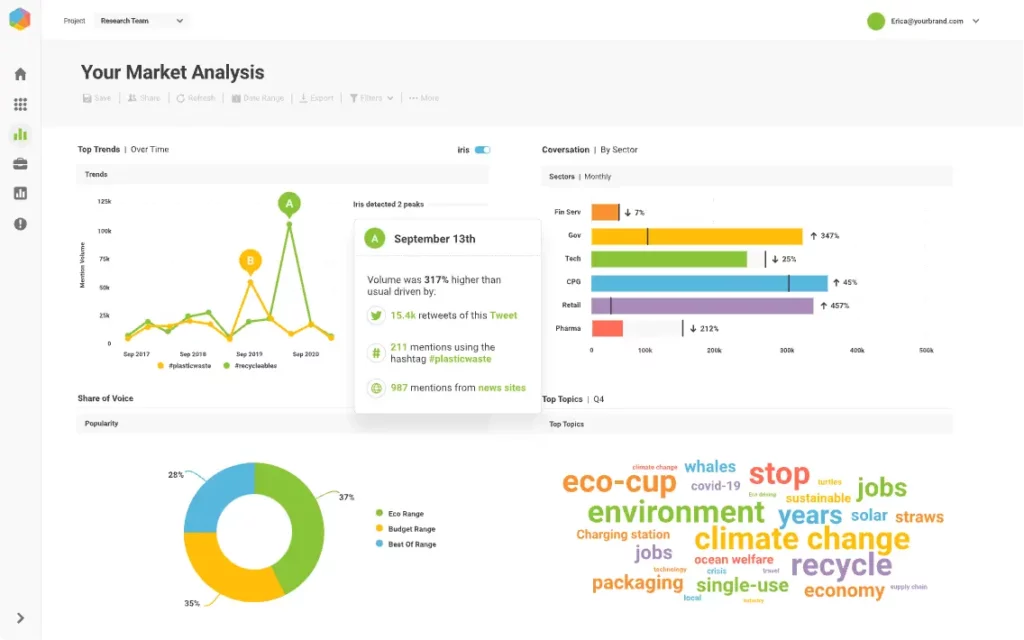
Brandwatch is a robust social listening and analytics tool that enables businesses to monitor, analyze, and gain insights from online conversations across various channels. It provides real-time data and powerful analytics features to track brand mentions, sentiment analysis, industry trends, and competitor activities.
Brandwatch offers a comprehensive suite of tools for social media listening, audience analysis, influencer identification, and reputation management. With its advanced capabilities and intuitive interface, Brandwatch is a valuable resource for businesses looking to understand and engage with their target audience effectively.
Pros
- Brandwatch offers extensive coverage of social media platforms, news sites, blogs, forums, and more
- The tool provides in-depth analysis of data, allowing businesses to uncover valuable insights and trends
- Brandwatch enables real-time tracking of brand mentions, allowing for immediate response and reputation management
- Businesses can monitor and analyze their competitors’ activities to gain a competitive edge
- Brandwatch allows users to create customized dashboards with specific metrics and visualizations to suit their needs
Cons
- Brandwatch’s pricing plans may be expensive for small businesses or individual users on a limited budget
- Due to its advanced features, Brandwatch can have a steeper learning curve compared to simpler social listening tools
- Customizing dashboards and reports may require more technical knowledge or support
- Some users find the interface to be overwhelming and not as intuitive as they would prefer
How to fit your social media content strategy into your overall marketing strategy
Integrating your social media content strategy into your overall marketing strategy is essential for achieving consistency and alignment across all your marketing efforts.
Here are some key steps to help you fit your social media content strategy seamlessly into your overall marketing strategy:
- Define your brand messaging – Make sure that your social media content reflects and reinforces your brand’s core messaging. Align your social media content with the overall brand tone, voice, and values.
- Establish goals and objectives – Identify how your social media content strategy supports your broader marketing goals. Whether it’s increasing brand awareness, driving website traffic, or generating leads, align your social media objectives with your overarching marketing objectives.
- Audience alignment – Make sure that your social media content strategy targets the same audience segments as your overall content marketing strategy. Analyze your target audience’s demographics, interests, and behaviors to create content that resonates with them across all channels.
- Consistent branding – Maintain consistent branding elements such as logos, color schemes, and visual styles in your social media content. This ensures a cohesive and recognizable brand presence across all marketing touchpoints.
- Cross-channel integration – Integrate your social media content with other marketing channels to create a unified customer experience. Coordinate messaging and campaigns across channels to reinforce your marketing messages and amplify their impact.
- Collaborative planning – Involve key stakeholders from different marketing teams in the planning and execution of your social media content strategy. Collaborate with teams responsible for PR, advertising, content, and other marketing functions to align messaging and leverage synergies.
- Performance tracking – Integrate social media metrics and analytics into your overall marketing reporting to evaluate the effectiveness of your social media content strategy. Assess how your social media efforts contribute to the overall marketing goals and make data-driven adjustments as necessary.
By aligning your social media marketing with your overall marketing strategy, you create a cohesive and unified brand presence across all channels.
It allows for consistent messaging, audience targeting, and measurement, resulting in a more impactful and integrated marketing approach.
Five examples of brands that are killing it on social media
Drawing inspiration from successful brands can help shape your own social media content strategy.
Here are five brands that are killing it on social media.
1. Wendy’s
Wendy’s, the popular fast-food chain, has achieved remarkable success on social media through its bold and witty approach. Known for its sassy and humorous tone, Wendy’s engages with its audience through clever comebacks, witty tweets, and timely pop culture references.
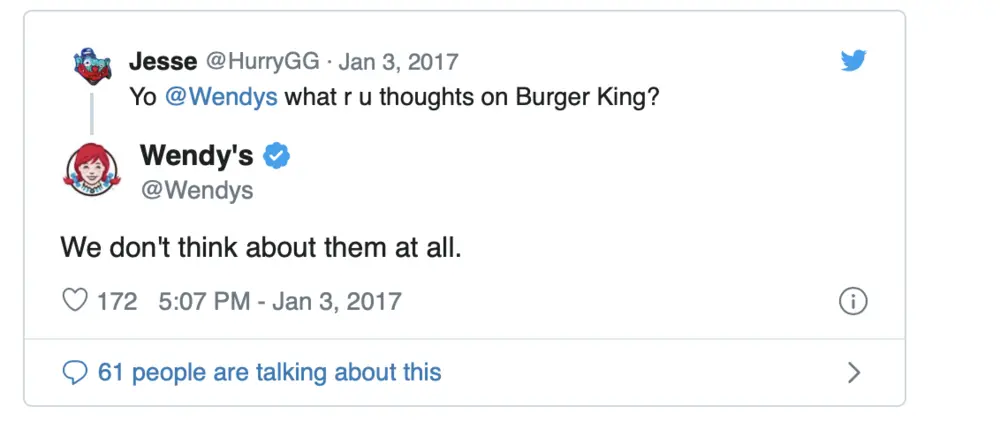
Source: indigo9digital.com
Their social media team’s quick wit and willingness to engage in playful banter with the followers helped Wendy’s create a large and devoted following. By jumping on trending topics, constantly relying on user-generated content, and creating viral campaigns like the #NuggsForCarter challenge, Wendy’s successfully captured attention and engagement on platforms like Twitter and Instagram.
This social media success has not only increased brand awareness but has also fostered a loyal and engaged community, making Wendy’s a standout example of how a well-executed social media strategy can contribute to a brand’s overall success.
2. Nike
Nike has achieved tremendous success on social media through its innovative and captivating content. As a leading global sports brand, Nike has become a synonym for using the power of storytelling to connect with its audience on an emotional level.
Through compelling videos, inspirational campaigns, and collaborations with top athletes and influencers, Nike created a powerful and engaged community. Their social media presence reflects their brand values of athleticism, determination, and empowerment.

Source: nike.com
Nike’s campaigns, such as “Just Do It,” have become iconic, resonating with millions of followers and driving widespread engagement. Don’t believe me? Check out our roundup of the best Nike marketing campaigns.
By leveraging user-generated content, showcasing diverse stories, and staying ahead of trends, Nike has solidified its position as a social media powerhouse, demonstrating how a well-crafted and authentic brand narrative can captivate and inspire audiences across various platforms.
3. GoPro
GoPro has achieved remarkable success on social media by tapping into the adventurous spirit of its users. As a company that produces rugged action cameras, GoPro has built a passionate community of content creators and adventure enthusiasts.
By encouraging users to share their (sometimes crazy) experiences captured with GoPro cameras, the brand has created a compelling and immersive social media presence. GoPro’s social media channels are filled with stunning user-generated content that showcases thrilling adventures, extreme sports, and breathtaking landscapes.
This content not only inspires and entertains but also serves as authentic testimonials for the quality and capabilities of GoPro cameras. By effectively harnessing the power of user-generated content, GoPro has created a dedicated and engaged fan base, establishing itself as a leader in the action camera industry.

Source: gopro.com
4. Airbnb
Airbnb has achieved significant success on social media by leveraging the power of user-generated content and storytelling. Through their social media channels, Airbnb showcases stunning and unique accommodations from around the world, allowing users to visualize themselves in these extraordinary spaces.
By curating and sharing engaging social media content from hosts and travelers, Airbnb has built an emotional connection with its audience, inspiring them to seek out authentic and memorable travel experiences.
The brand encourages users to share their own travel stories and experiences, turning them into brand advocates.
Airbnb’s social media success lies in its ability to tap into people’s aspirations for meaningful travel and to create a sense of belonging, fostering a vibrant community of travelers who trust and engage with the brand.
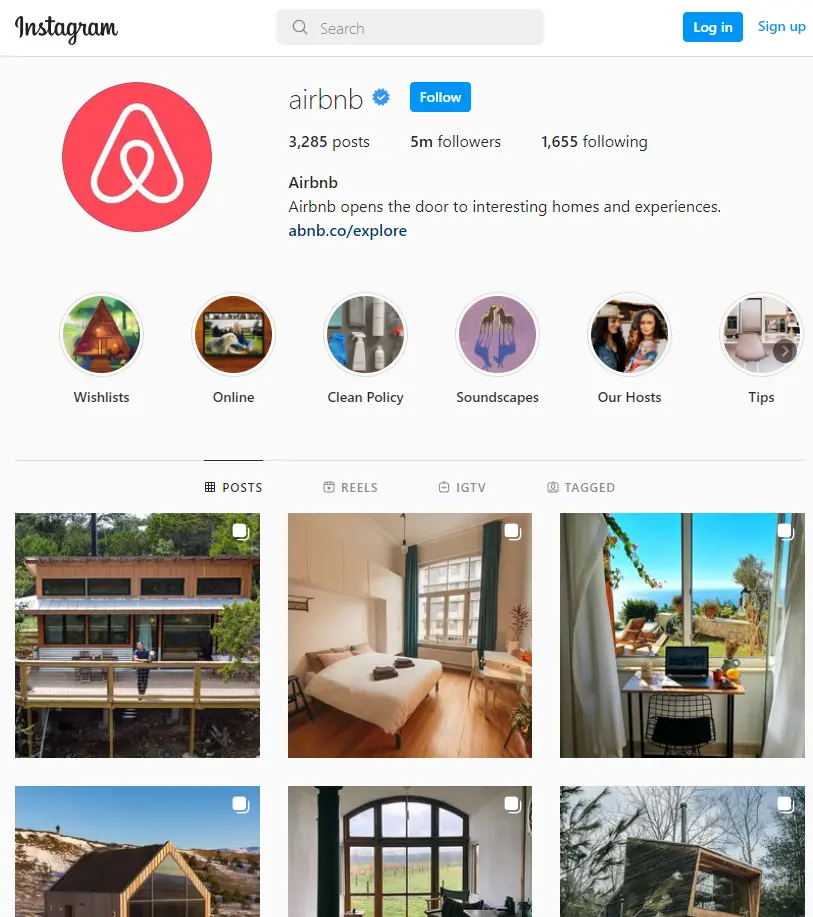
Source: exposureninja.com
5. Glossier
Glossier achieved remarkable success on social media by creating a community-driven beauty brand that resonates with its target audience. With a focus on natural, effortless beauty, Glossier has fostered an authentic and inclusive online presence.
Through their social media channels, Glossier shares user-generated content, featuring real people and their personal experiences with the brand’s products. This approach has not only built trust but also created a sense of community and connection among followers.
Glossier’s strategic use of influencers, interactive campaigns, and aesthetically pleasing visuals has further contributed to their social media success. By actively engaging with their audience, embracing transparency, and amplifying the voices of their customers, Glossier has established itself as a trailblazer in the beauty industry, inspiring and empowering their followers to embrace their natural beauty.

Source: skedsocial.com
Final thoughts
Social media content creation can be confusing and even a little scary without a proper strategy and tools in place. But if used properly, social media can do wonders for almost any business.
Hopefully this guide gave you a little push in the right direction and got you set and ready to start using social media as a valuable marketing channel. If you’d like to see first hand how Filestage can help you improve your overall social media content creation process, give it a try for free →










